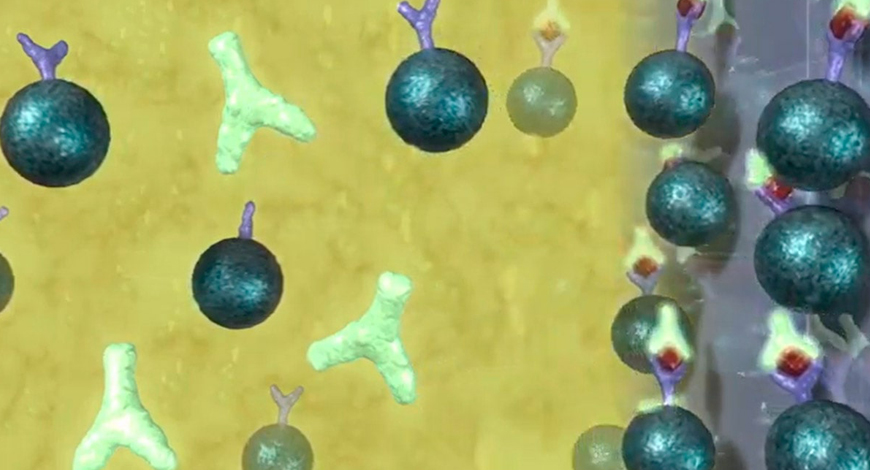Immunochemistry Instruments and Reagents
Backbone of diagnosis and prognosis

The need of today for accurate and precise measurement of the sensitive parameters, and for their rapid diagnosis.
The pandemic has changed many equations in the IVD industry. It was an eye opener to manufacturers around the world. There is an exponential growth in molecular diagnostics-based testing. Similarly, parameters like immunoglobulins, PCT, D-Dimer, CRP, and ferritin used as a prognosis tool for COVID contributed the growth in the immunochemistry segment. Immunochemistry has witnessed extraordinary advancement in every aspect of basic and clinical research, and this is owing to technological advances, which enable quantitatively and comprehensively measuring immune response to genetic or environmental perturbations.
Immunochemistry analyzers are becoming more and more popular these days as they have proved to be very effective tools to diagnose cancer, hepatitis, illegal drugs, fertility problems, infectious diseases, and many chronic diseases. With chemiluminescence immunoassay (CLIA) systems gaining momentum, this in turn results in a decline in ELISA tests. RIA and fluorescence immunoassay (FIA) are age-old procedures, which over time have been replaced by ELISA. Rapid tests can reveal the test results in less than 30 minutes; hence, these are preferred for screening. ELISA, on the other hand, continues to be trusted as a gold standard, owing to its extremely high sensitivity, specificity, precision, and throughput.
The last two decades have seen tremendous automation in ELISA technology. From a compact bench-top micro-strip processor, ELISA processors are now available with six plates, allowing reporting of over 500 test results in one go. Automated processors are equipped with robotic probes and dedicated workstations, which dramatically improve ELISA workflows. These fully automated processors are complete walkaway systems that minimize manual errors, while improving the accuracy and turnaround time for critical tests. Usually being open systems, the limitation of ELISA kits from a single source can also be ruled out.
The evolution of diagnostic and prognostic markers is significantly changing the clinical practice, and this can be demonstrated by the use of immunochemistry. The demand for immunochemistry has increased owing to overall increase in healthcare expenditure, decreasing mortality, increased awareness, and lifestyle-related diseases.
Immunochemistry is the backbone of diagnosis and prognosis of diseases in the healthcare system, and is thus the need of today for accurate and precise measurement of the sensitive parameters, and for their rapid diagnosis.
Going forward, more novel technologies, once reserved for specialized settings, such as molecular/virology, may increasingly migrate into the core laboratory.
Efforts are underway to connect both mass spectrometry and molecular diagnostics instruments to clinical chemistry systems. If mass spectrometry could be connected to chemistry and immunoassay analyzers on the same platform, drugs-of-abuse testing could be done in real time, with samples moving directly from immunoassay screening to confirmatory testing. Likewise, if molecular diagnostics instruments were to connect to core laboratories, chemistry and immunoassay testing could be combined for diagnosing and monitoring infectious diseases, with follow-up molecular confirmation, using the same sample on the same track. The risk of contamination for molecular diagnostics tests has been a barrier in the past, but companies are coming up with new ways to manage this risk.
When purchasing an immunoassay analyzer, lab professionals should consider:
Automation. An analyzer, which offers greater automation, reduces the workload of professionals, while reducing the possibility of human error;
Return on investment. If the analyzer in question can allow the laboratory to function at a faster rate or with greater efficiency, then the laboratory will be able to improve productivity and in turn, increase profitability.
Improved precision. When purchasing a modern analyzer with the latest technology in comparison to an older product, the newer software will likely allow for more precise results, which will improve the validity of output data within the laboratory.
Lab leaders will benefit from choosing instruments that require minimal human intervention and training for processing samples, while allowing the option to scale up as needed to meet future demands. Automated immunoassay analyzers enable lab staff to save time, standardize processes and reduce errors. Lab leaders should also consider the support and service options available from various manufacturers, as the one they choose will play an important role in facilitating uninterrupted processing of critical assays.
Laboratory professionals should always keep in mind what the future might bring to their laboratory. Purchasing for today’s needs may not position the laboratory appropriately for future growth and expansion.











